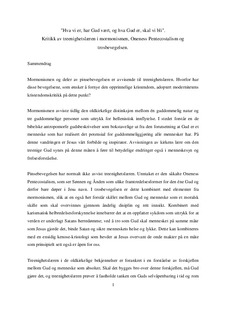| dc.contributor.author | Alfsvåg, Knut | |
| dc.date.accessioned | 2015-05-07T10:01:42Z | |
| dc.date.accessioned | 2016-04-25T11:45:39Z | |
| dc.date.available | 2015-05-07T10:01:42Z | |
| dc.date.available | 2016-04-25T11:45:39Z | |
| dc.date.issued | 2014 | |
| dc.identifier.citation | Theofilos 2014, 6(1):38-47 | nb_NO |
| dc.identifier.issn | 1893-7969 | |
| dc.identifier.uri | http://hdl.handle.net/11250/2387171 | |
| dc.description.abstract | Mormonismen avviser den oldkirkelige distinksjon mellom én guddommelig natur og tre guddommelige personer som uttrykk for hellenistisk innflytelse, og foretrekker en bokstavelig forståelse av de antropomorfe gudsbeskrivelser som uttrykk for at Gud er et menneske som har realisert sitt potensial for guddommeliggjøring. Innenfor pinsebevegelsen er treenighetslæren avvist av den såkalte Oneness Pentecostalism, som ser Sønnen og Ånden som ulike framtredelsesformer for den éne Gud. I trosbevegelsen er dette kombinert med elementer fra mormonismen, og tanken er da at ved å tro som Gud skal mennesket binde Satan og sikre menneskets helse og lykke. I klassisk treenighetslære oppfattes forskjellen mellom Gud og menneske som absolutt, men likevel overvunnet gjennom inkarnasjonen. Når en erstatter dette med en modell hvor motsetningen mellom Gud og menneske tolkes i moralske kategorier, problematiseres det skapte, og målsetningen for menneskets utvikling blir frigjøring fra skaptheten. | nb_NO |
| dc.description.abstract | Mormonism and parts of the Pentecostal movement reject the traditional doctrine of the Trinity. Why have these movements, which want to renew the original understanding of the Christian faith, adopted this aspect of modernity's critique of Christianity? Mormonism reject the distinction of the old church between the one divine nature and the three divine persons as an expression of Hellenistic influence. The Mormons understand the biblical anthropomorphisms literally, interpreting them from the presupposition that God is a human who has fully realized the human potential for divinization. On our journey toward this goal, Jesus is our model and inspiration. The rejection of the tradition doctrine of the Trinity thus implies significant alterations also in terms of anthropology and soteriology. The Pentecostal movement normally does not reject the doctrine of the Trinity. The exception is Oneness Pentecostalism, which considers the Son and the Spirit as different modes of appearance of the same God, and therefore only performs baptisms in Jesus' name. In the faith movement this is combined with elements from the doctrine of Mormonism issuing in a common emphasis on the understanding of the difference between God and human as a moral difference to be overcome through spiritual discipline and right knowledge. When this is combined with a charismatic emphasis on healing, one tends to understand illness as a result of the world being dominated by Satan. The task of the believer is then, following in the footsteps of Jesus, to take Satan captive and thus realize human health and wealth. This may be combined with a one-sided kenotic Christology, interpreting Jesus' victory over the evil powers as something that also is possible for us in basically the same way. The doctrine of the Trinity in the confessions of the old church is founded on the understanding of the difference between God and human as absolute. It can then only be bridged from God's side, and the doctrine of the Trinity is an attempt to maintain that God actually has revealed himself within time and space without divinity thereby being altered. By receiving this revelation in faith, humans are enabled to relate to the created world as originally intended. By replacing this with a model according to which the difference between God and humans is interpreted in moral categories, one makes the created world into a problem, and the goal for human development is seen in the humans' liberation from the restrictions of creation. How can this rejection of the ecumenical Christian understanding of the Trinity have such a broad appeal? One may understand the old church's adoption of philosophical categories to express the doctrine of the Trinity as a parallel to what is considered as uncritical accommodation to contemporary philosophies within the established Churches. If this is the case, however, it represents a rather crude approach to the doctrine of the Trinity in the confessions of the old church. | nb_NO |
| dc.language.iso | nob | nb_NO |
| dc.title | Hva vi er, har Gud vært, og hva vi er, skal Gud bli: Kritikk av treenighetslæren i mormonismen, Oneness Pentecostalism og trosbevegelsen | nb_NO |
| dc.title.alternative | What we are, God was, and what God is, we shall be: A critique of the doctrine of the Trinity in Mormonism, Oneness Pentecostalism and the faith movement. | nb_NO |
| dc.type | Journal article | nb_NO |
| dc.date.updated | 2015-05-07T10:01:42Z | |
| dc.subject.nsi | VDP::Humaniora: 000::Teologi og religionsvitenskap: 150::Teologi: 151 | nb_NO |
| dc.subject.nsi | VDP::Humanities: 000::Theology and religious studies: 150::Theology: 151 | nb_NO |
| dc.source.pagenumber | 38-47 | nb_NO |
| dc.source.volume | 6 | nb_NO |
| dc.source.journal | Theofilos | nb_NO |
| dc.source.issue | 1 | nb_NO |
| dc.identifier.cristin | 1144103 | |
| dc.subject.keyword | Menneskesyn / View of humanity | |
| dc.subject.keyword | Mormonisme / Mormonism | |
| dc.subject.keyword | Treenighet / Trinity | |
| dc.subject.keyword | Trosbevegelsen / Faith movement | |
